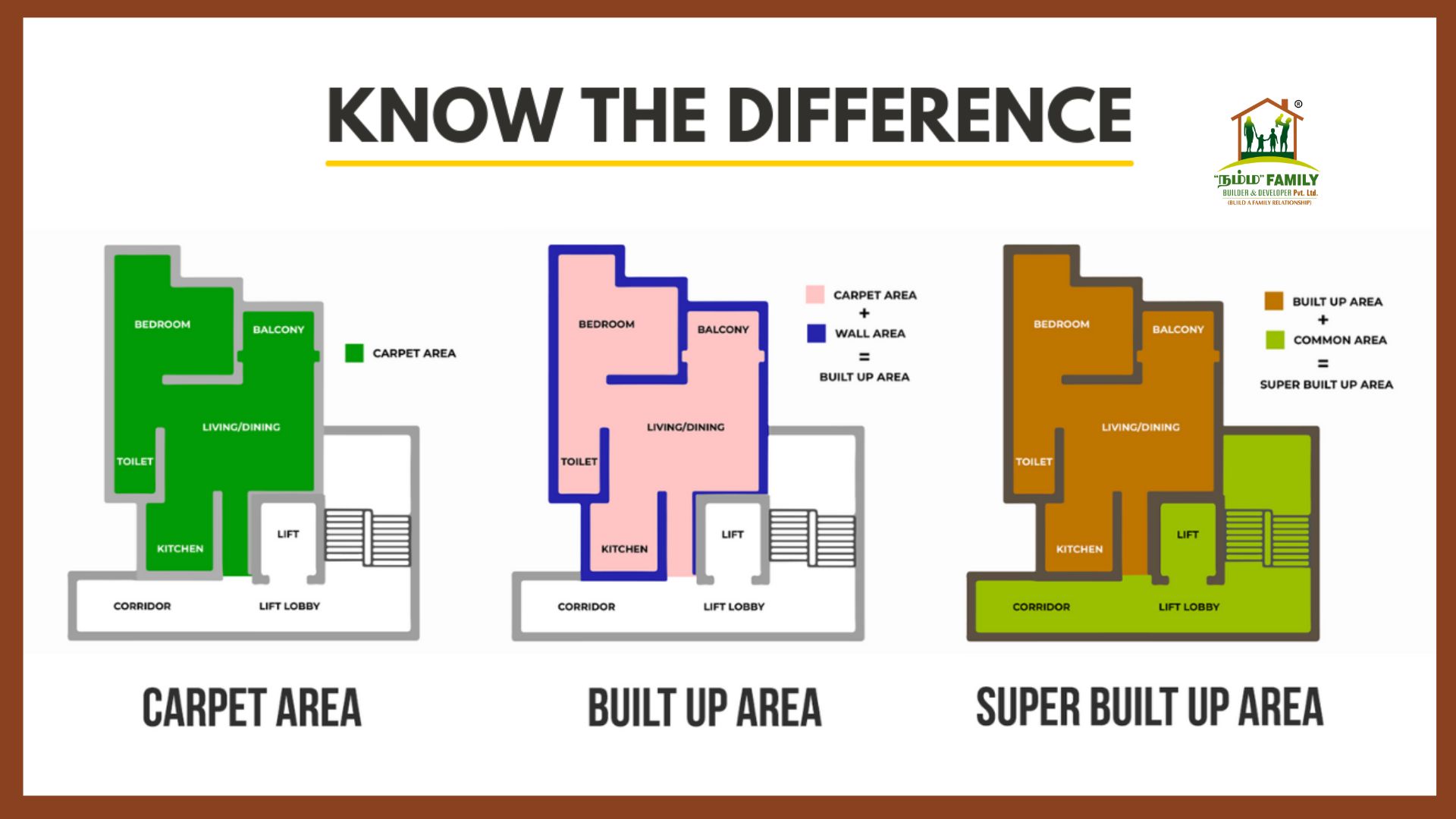
Best Guidance for Carpet Area, Built-Up Area, and Super Builtup Area

Carpet Area, Built-Up Area, and Super Builtup Area:
- When buying a home in real estate, you usually pay for the number of square feet it will occupy. Understanding the differences between the various types of area measurements is essential for both the buyer and the seller.
- Generally, carpet area, built-up area, and super built-up area are three measurements that are very important. Among them, the carpet area is the most important as it directly reflects the usable space of the occupants.
What Is Carpet Area?
A carpet area is the net usable area or carpeted area of a living space such as a flat or apartment. It also refers to the actual usable space in the property excluding the thickness of the walls. It is used to define the distance between interior walls. These include interior walls such as living room, bedroom, bathroom, and kitchen, balconies and indoor stairs, etc. Excludes external walls such as corridors, terraces, lifts, and utility pipes.
What Is RERA Carpet Area?
As per the RERA Act 2016, the RERA Carpet Area is the net usable area including the thickness of the interior walls of a dwelling or house excluding areas like outdoor areas, common areas, balconies, terraces, and verandah areas. RERA carpet area is about 5% more than carpet area.
How To Calculate Carpet Area And RERA Carpet Area?
A simple formula for calculating carpet area is:
Carpet Area = Bedroom+Living Room+Kitchen+Balcony+Toilets – Thickness of Internal Walls
Generally, in some cases, the carpet area in an apartment is 70% to 90% of the total built-up area.
As per the RERA Act 2016,
The formula for calculating the RERA Carpet Area is:
RERA Carpet Area = Net usable area of dwelling+areas of partition walls
Importance Of Carpet Area
1. Accurate assessment of usable space:
The carpet area provides an estimate of the actual living and working space available to the occupants. It refers to the area where daily-use items can be kept apart from the thickness of the walls.
2. Transparency in pricing:
Carpet area plays an important role in pricing the value of a property. As it represents actual usable space, it is a reasonable basis for pricing negotiations.
3. Evaluation of Performance and Functionality:
- The carpet area also helps in evaluating the performance and functionality of a property. Buyers can determine the rooms and storage space available within this area.
4. Investment Truth:
The carpet area is an important factor for investors looking to rent or lease a property. Usable space directly affects net income and tenant preference. Investors can measure potential net income or resale value based on carpet area.
What Is a Built-up Area?
The built-up area is the total area of a flat or building, covered by amenities such as carpet area, external walls, common areas, etc. It is a proportionate share of shared facilities like total carpet area, corridors, lifts, stairs, etc.
How To Calculate Built-up Area?
The built-up area is calculated as carpet area or RERA carpet area, interior & exterior wall area, balcony, and corridor.
Built up Area=Carpet Area &RERA Carpet Area+Internal & External Wall Areas+Balcony & Terrace+Walkway
The built-up area is 10 to 15% more than the carpet area.
Importance Of Built-up Area
1. Detailed space estimation:
- The built-up area provides a detailed measurement of the covered space in a property. It includes carpet areas and covered areas like corridors, and balconies.
2. Pricing and Valuation:
It plays an important role in pricing the value of a property. It also acts as a key factor in calculating the price per square foot and helps buyers accurately compare properties.
3. Planning and Design:
The built-up area helps with planning and design decisions. It helps architects and interior designers to efficiently allocate available space.
4. Legal and Regulatory Compliance:
As per RERA rules the developer must provide full disclosure of the built-up area. This ensures transparency and compliance with legal requirements.
What Is a Super Built-up Area?
A Super built-up area or salable area is the combination of a total built-up area and a proportional amount of public spaces like a lift area, stairs, and passageways. It also includes amenity areas such as a swimming pool, clubhouse, and gardens.
How To Calculate Super Built-up Area?
To calculate the super built-up area builders or developers add the percentage of common areas like lift lobbies, stairwells, and passageways to the total built-up area of the apartment. The added percentage varies from project to project and can range from 20 to 50%.
The formula for calculating super built-up area:
Super built-up area = built-up area + proportional common area
Importance Of Super Built-up Area
1. Cost Calculation and Transparency:
The Super built-up area serves as the basis for cost and cost calculations. It also includes shared spaces like carpet areas, built-up areas, super built-up areas, corridors, and other facilities.
2. Inclusion of shared facilities:
This includes a proportionate share of common spaces and other facilities. This ensures that the cost of maintenance and provision of shared facilities is distributed among the buyers.
3. Investment Considerations:
Investors in real estate often consider the super built-up area when estimating the rental income or resale value of a property. Adding shared amenities and facilities improves the property’s market appeal and potential rents.
4. Legal and Regulatory Compliance:
Many regions have regulations requiring the disclosure of super-built-up areas. It ensures transparency and compliance with legal requirements.
What Is The Loading Factor?
The difference between the super built-up area and the carpeted area of the flat is called the loading factor. The cost of facilities and amenities provided in the project is to be recovered. This loading factor also includes common facilities like lifts, lobbies, stairs, balconies, maintenance rooms, parking, and terraces. Loading Factor of Apartment Generally less than 60%. Above 60% there is more super built-up area and less carpet area.
How To Calculate Loading Factor?
The formula for calculating the Loading Factor:
Loading Factor = Super built-up area – Carpet area
If the loading factor is 1.3, it means that your developer has added 30% to your carpet area. Also, the super built-up area is 1300 square feet and the carpet area is 1000 square feet.
Difference Between Carpet Area, Builtup Area, and Super Built-up Area
It is very important to know the difference between carpet area, built-up area, and super built-up area in the real estate industry. They are:
Carpet Area: Carpet area refers to the daily usable internal area of the property excluding the thickness of the walls. It includes enclosed areas such as a kitchen, bathroom, and bedroom.
Buildup Area: Buildup area refers to the thickness of walls and carpet area. It also includes enclosed spaces like bedrooms, kitchens, bathrooms, corridors, and balconies. It considers the internal aspects of the property including the built-up area.
Super buildup area: The super built-up area extends over the carpet area and built-up area and includes common spaces and shared facilities. It represents the total area of the space paid for by the buyer including common spaces. It is a more inclusive measure that calculates the overall space available to the buyer.
Area | Carpet Area | Built up Area | Super Built-up Area |
Bedroom | Yes | Yes | Yes |
Living Room | Yes | Yes | Yes |
Bath Room | Yes | Yes | Yes |
Kitchen | Yes | Yes | Yes |
Study Room | Yes | Yes | Yes |
Guest Room | Yes | Yes | Yes |
Kids Room | Yes | Yes | Yes |
Dining Room | Yes | Yes | Yes |
Lobby | No | No | Yes |
Balcony | No | Yes | Yes |
External Staircase | No | Yes | Yes |
Internal Staircase | Yes | Yes | Yes |
Pooja Room | Yes | Yes | Yes |
Terrace | No | Yes | Yes |
Lift | No | Yes | Yes |
Verandah | No | Yes | Yes |
Garden | No | No | Yes |
Conclusion
Knowing the difference between carpet area, built-up area, and super built-up area is very important for anyone who is planning to buy a property in the real estate industry. These metrics are about usable space, price, and property values Provide insights. Whether you are a buyer or a seller, being familiar with these metrics helps you make better decisions and negotiate deals fairly. If you are looking for the best guidance and assistance in buying a property in the real estate market, contact the Namma family of builders and developers right away. Ready to locate and provide a seamless experience.









